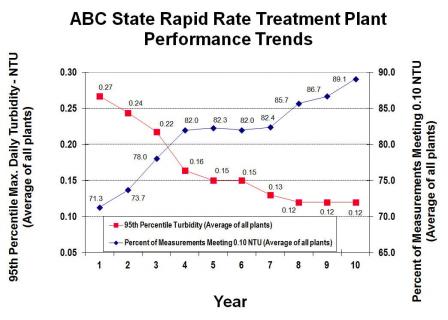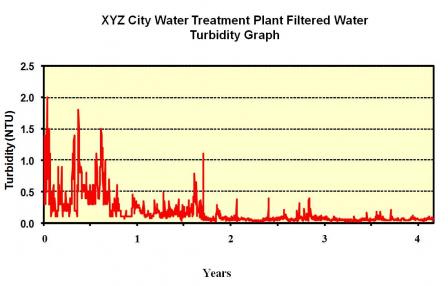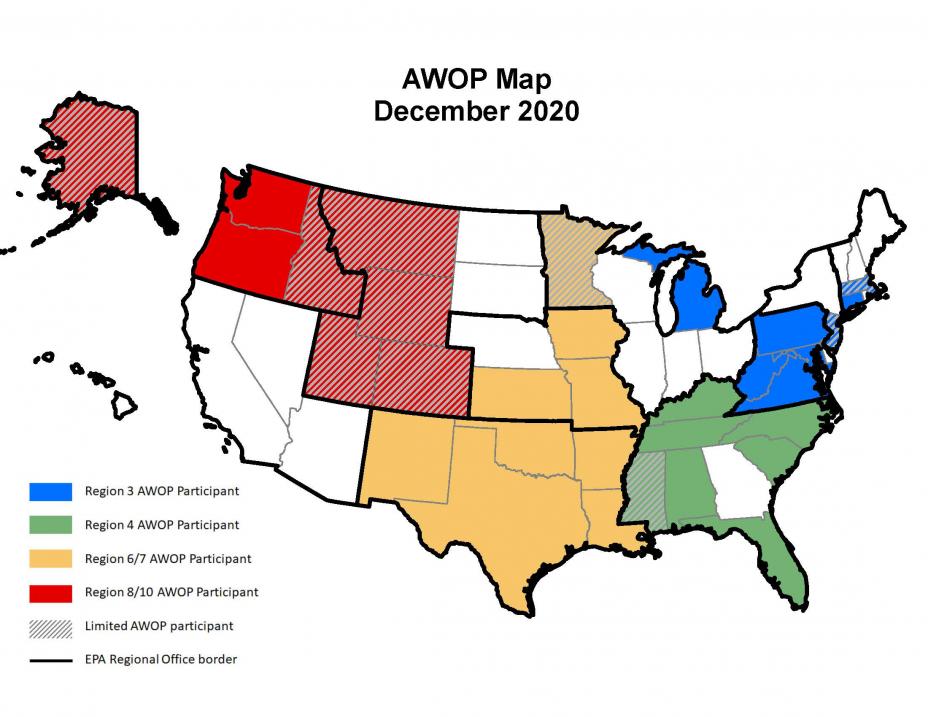Optimization Program for Drinking Water Systems
The Area-Wide Optimization Program (AWOP) provides tools and approaches for drinking water systems to meet water quality optimization goals and provide an increased – and sustainable – level of public health protection to their consumers.
AWOP tools can also be utilized to provide compliance assistance through optimization, particularly for small- and medium-sized systems. The program teaches problem-solving skills designed to improve operations at drinking water systems without costly capital improvements.
The optimization goals are more stringent than the regulations and State participation in AWOP is voluntary. Realizing the many benefits the program provides, six EPA Regions currently implement multi-state (“Area Wide”) optimization programs.
Learn More
EPA designed AWOP to enhance public health protection through optimizing the performance of existing facilities. State drinking water agencies implement AWOP with support from EPA.
AWOP is a cost-effective approach to:
- Increasing public health protection
- Proactively achieving regulatory compliance
- Improving treatment plant performance
- Maintaining high water quality throughout the distribution system
A successful AWOP includes three key components:
- Status - Enhanced surveillance of PWS performance, which helps states determine the relative need of their systems (based on water quality and anticipated public health risk) and target their assistance to those most in need.
- Targeted Performance Improvement - Targeting activities for improving drinking water quality to “optimum” levels that go beyond regulatory requirements; this training helps transfer water treatment skills to water system operators and sustain improvements in drinking water quality.
- Maintenance - Ongoing improvement of AWOP activities to sustain and enhance the program through collaboration with partner states in the AWOP network and integration of optimization approaches into other state drinking water programs.
Benefits
States that participate in Area-Wide Optimization Program (AWOP) have cited multiple benefits including:
- Improved treatment plant performance and public health protection
- Effective compliance assistance for small (and large) water systems
- Enhanced state staff and water system staff capability and morale
- Effective use of state resources
Each is described in more detail below:
Improved Treatment Plant Performance and Public Health Protection
- Long-term, sustainable, approach
- Enhanced capability of water system operators
- Data-based, results-driven program
- Treatment Plant Performance Trends
 Average turbidity performance data from all of the rapid rate surface water treatment plants from an AWOP state. On the primary y-axis the maximum daily turbidity is plotted in units of NTU; on the secondary y-axis the percent of measurements meeting 0.1 NTU, which is the filtered water turbidity performance goal for this state. These data are shown over a 10-year period. Throughout this time the average maximum turbidity consistently decreased (starting at 0.27 NTU and dropping to 0.12 NTU). Additionally, the percent of the measurements meeting the AWOP goal consistently increased from 71.3 to 89.1%.
Average turbidity performance data from all of the rapid rate surface water treatment plants from an AWOP state. On the primary y-axis the maximum daily turbidity is plotted in units of NTU; on the secondary y-axis the percent of measurements meeting 0.1 NTU, which is the filtered water turbidity performance goal for this state. These data are shown over a 10-year period. Throughout this time the average maximum turbidity consistently decreased (starting at 0.27 NTU and dropping to 0.12 NTU). Additionally, the percent of the measurements meeting the AWOP goal consistently increased from 71.3 to 89.1%.
Effective Compliance Assistance for Small (and Large) Water Systems
- Provides cost-effective compliance approach
- Focuses on improving operations rather than costly capital improvements
 Demonstration of the impact of AWOP activities on filter plant performance as measured by filtered water turbidity over a four-year period. Turbidity is plotted on the y-axis, in units of NTU, and the data indicate that during the first year the plant consistently had turbidity spikes above 1 NTU (and as high as 2 NTU) – averaging approximately 0.7 NTU. Into the second year the average turbidity dropped to approximately 0.5 NTU (with the exception of two brief spikes at the end of the year 2). By the third year turbidity was consistently below 0.5 NTU (averaging approximately 0.2 NTU). During the fourth year the turbidity dropped even further and was maintained at or near the optimization performance goal for much of that year. The system demonstrated excellent performance during the last 6 months shown.
Demonstration of the impact of AWOP activities on filter plant performance as measured by filtered water turbidity over a four-year period. Turbidity is plotted on the y-axis, in units of NTU, and the data indicate that during the first year the plant consistently had turbidity spikes above 1 NTU (and as high as 2 NTU) – averaging approximately 0.7 NTU. Into the second year the average turbidity dropped to approximately 0.5 NTU (with the exception of two brief spikes at the end of the year 2). By the third year turbidity was consistently below 0.5 NTU (averaging approximately 0.2 NTU). During the fourth year the turbidity dropped even further and was maintained at or near the optimization performance goal for much of that year. The system demonstrated excellent performance during the last 6 months shown.
Enhanced State Staff and Water System Staff Capability and Motivation
- Optimization tools are field-proven and state AWOP participants receive training on their use
- Water system staff technical understanding and self-confidence increases
Effective Use of State Resources
- States track water system performance state-wide
- Resources are allocated to systems most in need
- The correct tool is targeted for each system
Become Involved
States and Regions may both participate in AWOP; we particularly encourage participation by the parent Regions when one or more of their states is engaged. For more information about participating contact:
Rick Lieberman
(lieberman.richard@epa.gov)
513-569-7604
Participants
The Area-Wide Optimization Program (AWOP) is a unique partnership among EPA, State agencies, and supporting organizations that fosters the continued growth of the program. They include:
- EPA Office of Ground Water and Drinking Water (OGWDW), Standards and Risk Management Division, Technical Support Center (TSC) Cincinnati, OH: leads the development and implementation of AWOP activities nation-wide and helps sustain the network of participating states and water systems.
- OGWDW Drinking Water Protection Division (Washington, DC): supports the integration of AWOP into Capacity Development, technical assistance programs, and regulatory implementation and compliance strategies.
- As of July 2019, EPA Regions 3, 4, 6, 7, 8 and 10: use AWOP to support direct implementation responsibilities, sustain the AWOP by facilitating state implementation, and support the development of new optimization approaches.
- Association of State Drinking Water Administrators (ASDWA): supports and advocates the implementation of AWOP within existing (and potential) state drinking water programs.
- State participation, as of July 2019 is depicted in the map that follows:
Related Information
- Association of State Drinking Water Administrators (ASDWA) AWOP pageExit - additional information on the Area-Wide Optimization Program (AWOP).
- Hydrant sampler video, parts list and procedure - allows for the efficient collection of samples throughout a water distribution system.
- Handbook: Optimizing Water Treatment Plant Performance Using the Composite Correction Program (PDF)(268 pp, 2.6 MB, About PDF) - resource document for optimizing the performance of existing surface water treatment facilities to provide protection from microbial contamination.
- Optimization Tools for Reducing Disinfection Byproducts - includes a four-part recorded webinar series introducing tools that water systems can use as well as several study protocols and supporting spreadsheets.
- Generating High-Quality Turbidity Data in Drinking Water Treatment Plants to Support System Optimization and Monitoring document - This document describes the common turbidimeter setups and associated Supervisory Control and Data Acquisition (SCADA) systems used in drinking water treatment plants and identifies “best practices” approaches to help ensure data quality.
- Optimization Assessment Spreadsheet (XLSM)(1 MB, 815-B-19-017)
- Implementing AWOPs through the Capacity Development and Drinking Water State Revolving Fund Programs (PDF)(4 pp, 475 K, About PDF) - fact sheet highlighting how the Capacity Development and Drinking Water State Revolving Fund programs give states the authority, tools and resources needed to implement AWOPs.

